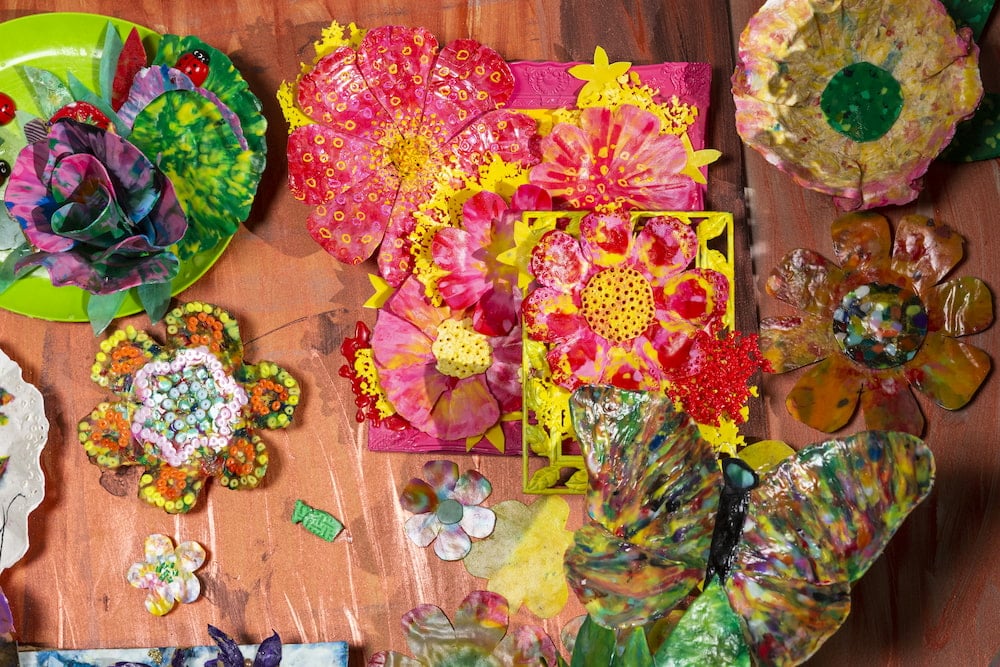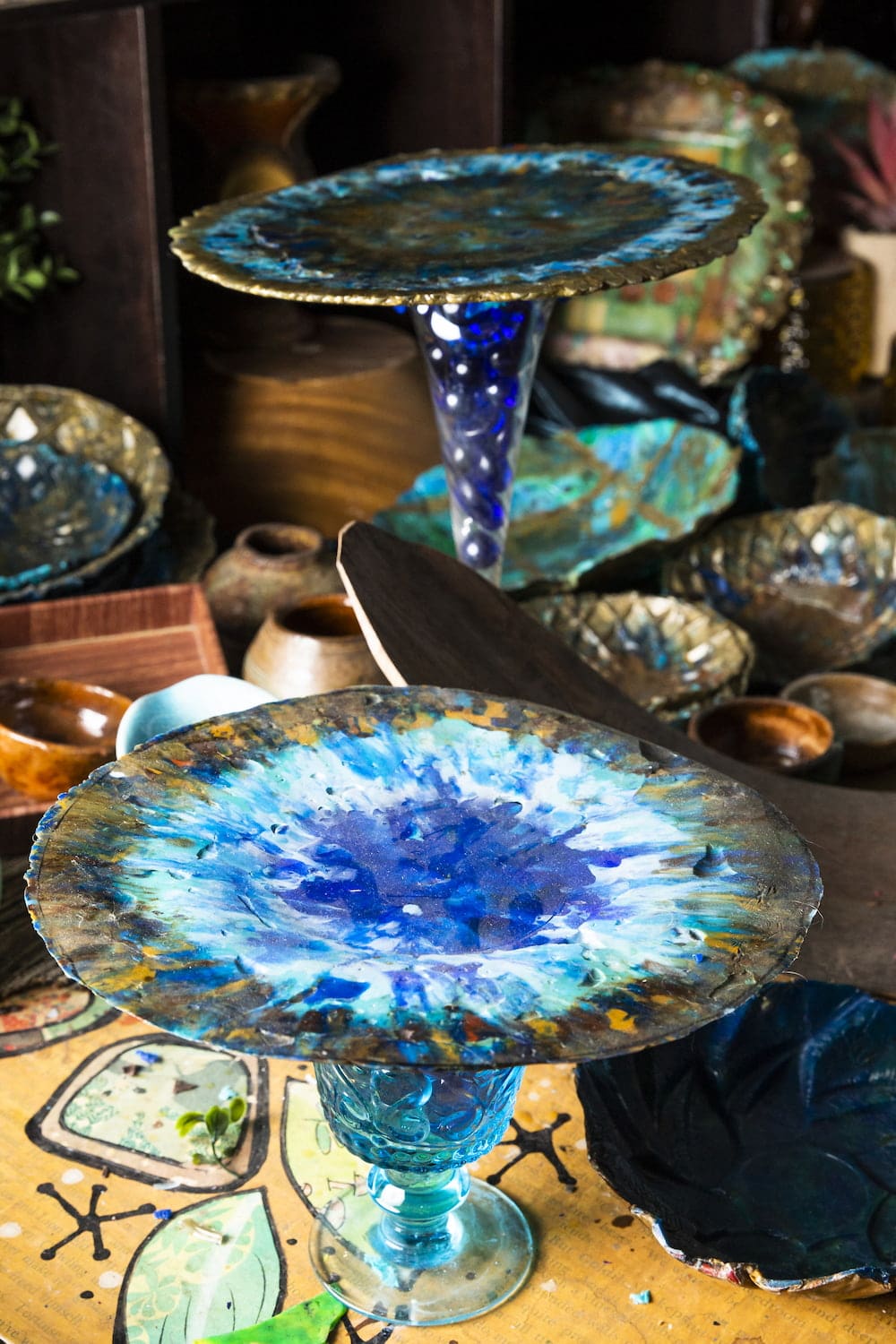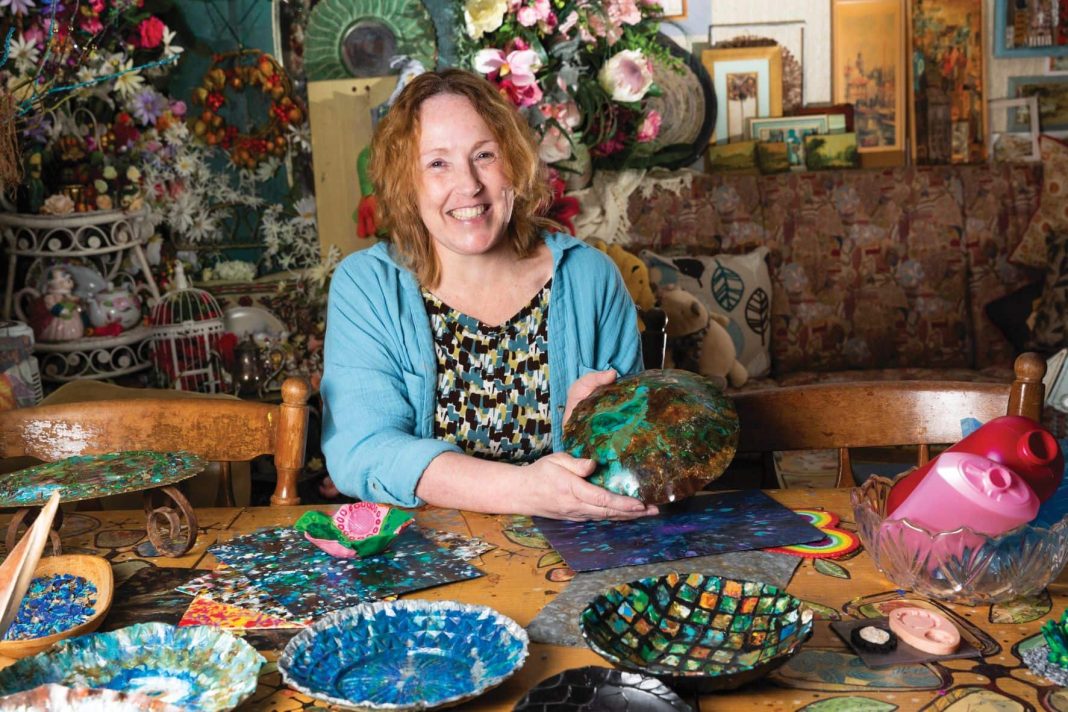Canberra could become the first city in the world to design with plastic, designer Candice Addicoat believes. She has pioneered a world-first technique to turn polyethylene plastic into art and household items – but envisages a time when nearly everything is made from recycled PE plastic.
“As a whole community, from entertaining at home, construction, and creation at school, to planks and sheets for making cubbyhouses or doghouses, up to building materials, the whole community could use a lot more than we’re recycling,” Ms Addicoat says.
An exhibition at Floriade this month will encourage Canberra to set a world record, and throw down the gauntlet to others.
Only 9 per cent of plastic waste (227,000 tonnes) is sent for recycling, and 84 per cent (2.1 million tonnes) is sent to landfill, according to the Australian Bureau of Statistics (2020); while only 2 per cent of recycled plastic gets back into circulation, Ms Addicoat notes.
“Polyethylene is the world’s biggest plastic problem on the planet purely by volume,” she explains.
The most made plastic, it comprised 32 per cent of plastic waste in 2020 – and, with the fastest growing production rate (2.7 per cent), it is expected to reach half of all plastics within the next decade.
Unstopped, that plastic is bad news for the environment – but Ms Addicoat believes this “dire environmental nuisance” can be made into “beautiful, purposeful or practical items”.

“It addresses our biggest plastic problem, but in an engaging way that pretty much all ages and abilities can recycle this plastic or repurpose this plastic … knowing it’s not going where it’s not meant to go.”
Eighteen months ago, Lids4Kids asked Ms Addicoat whether she could stick plastic caps to her ‘junk funk’ artwork. Their campaign to collect bottle tops to melt down for children’s prosthetics had collected enough for five years, in its first three months.
Ms Addicoat realised that the lids were made from the same plastic as children’s plastic melting beads – and as shampoo bottles or plastic bags.
“I found it a bit dumbfounding that for 50 years, kids have been melting the exact same plastic which we buy brand new, and that people are throwing away beautiful colours equal or more than the amount that they’re paying for new.
“It was, accidentally, a world first. I looked at what other people were doing with their waste polyethylene. There are a few wobbly bowls out there; that’s about it other than the commercial recycled plastic – which is very expensive equipment, not everyday stuff.”
You or I might chuck that maroon shampoo bottle in the recycling; Ms Addicoat cuts it up, melts it in her sandwich press … and five minutes later, voilà! An A4 craft sheet.
“As a designer, it’s the most interesting, versatile, and vibrant material I’ve ever worked with,” she says. “It’s so quick, so easy, so safe, so almost organic in the way things can look.”
That craft sheet might become a lamp, a platter or dipping bowl in a 17-piece entertaining set, a cake platter, or a cameo brooch.
Tomato sauce bottles, mustard bottles, gold milk lids, and children’s plastic beads become a placemat with a gecko design – a translucent gecko: hold it up to a light, and it glows with new colours.

Those are objects people could make at home, Ms Addicoat says.
“One of the things that I love when I’m talking about this with parents, teachers, and children is that they know that if they make a cereal bowl, five or six bottles, or lids, or containers aren’t going to end up in landfill, or the ocean, or the environment. They can keep it, and they know that when they don’t want it anymore, it can be made into something else useful.”
Polyethylene binds well with other unrecycled material: glass or metal (to make cake stands); paper (an old National Geographic makes a five-piece Incan set); or waste fabric (to make waterproof handbags, shoes, outdoor furniture coverings, or awnings).
“The potential to see where it can go is pretty much endless,” Ms Addicoat says.
Polyethylene is not toxic, and has been used in 3D printers, as well as by children, for decades, Ms Addicoat explains.
Nor does it stink; the fumes smell like paraffin wax, “like you’ve blown out candles in one go”. Its microplastics are slow to decay: that’s bad for the environment, if it ends up in landfill – but an advantage if used to build cubbyhouses, kennels, or park benches, since the microplastics are inert, she says.

Her exhibition at Floriade, Plasticus Botanica (the plastic garden), will showcase bigger artworks: the large, backlit native botanicals she has made with the Strong Aboriginal Women’s Group: waratah lamps or illuminated wattle bushes, for instance. (Another exhibit could be held at the Legislative Assembly during National Recycling Week in November.)
She hopes visitors will go home realising what they can do with plastic, and set a brand-new record for polyethylene.
“The idea is that Canberra becomes the first city to design with it [recycled plastic], get all the kinks out of the system, get it all sorted, and then any city or town around the world could pick up the same system and keep this plastic from ending up in the wrong place.
“The great thing about setting the record is that other cities would have to use even more to break the record, and then maybe another city would use even more. Down the track, we might want to take the record back.”
Part of the world record initiative is to get a mini plastic shredder for each school and a bank of shredders at community centres to make shredded plastic.
“If it’s a standard at schools, children growing up with it will come up with so many techniques and ideas and creations. In schools is where it will boom.”

Woodwork teachers could become polywork teachers, working with a 100 per cent recyclable material, while children could collect plastics in their favourite colours, swap them at school, and make their own lolly dishes, cupcake holders, and party hats at birthdays.
“The potential to play with it is endless,” Ms Addicoat says. “It’s the most fun form of recycling on the planet!”
A bigger shredder can make two tonnes of plastic a day, which could be used by schools, universities, or artists, while the same facility could make planks and sheets of plastic.
That, Ms Addicoat intends, could be used as building material for city renewal projects, school desktops, bus shelters, benches, or tactile paving for blind people at traffic stops.
Since PE plastic takes up the exact texture of other materials (stone, granite, glass, or metal), a non-slip sample could become garden pavers, garden paths, or a retaining wall, and be embedded with solar-powered LEDs to make a glowing feature at night-time.
“We’ve got so much stuff lying around,” Ms Addicoat says. “It’s almost going back to the beginning when there were trees, rocks, clay, and sand lying around, and we just picked them up and created. … I feel it’s going to be an age of innovation and creation.”
For more information, visit Plastic Static, a platform to share ideas, pictures, techniques, and facts about used PE plastic. The website is part of the PlastiSCENE program, a recycled plastic initiative of Ms Addicoat’s community improvement and engagement charity, SCENE.
SCENE refurbishes community organisations, housing estates, and care facilities, turning so-called junk into art and furniture. Ms Addicoat is putting free videos of her junk décor workshops online for the community to access. They are suitable for all ages and abilities, from beginners, children, people with special needs, and the aged to DIY enthusiasts, artists, and designers.



